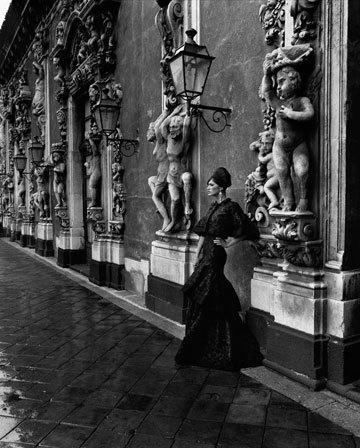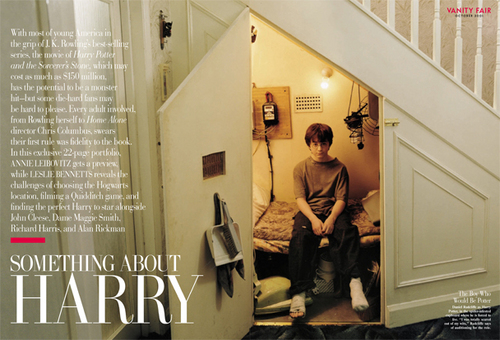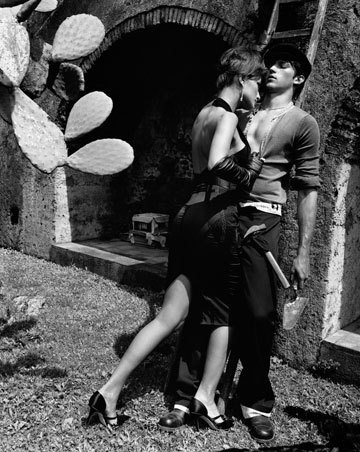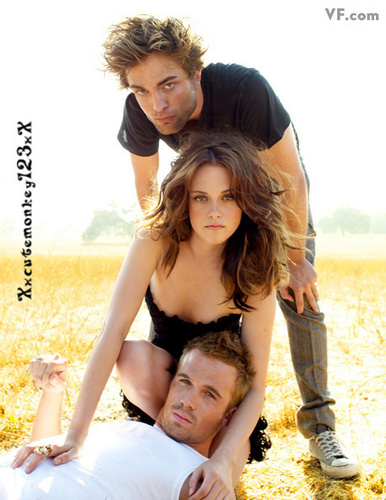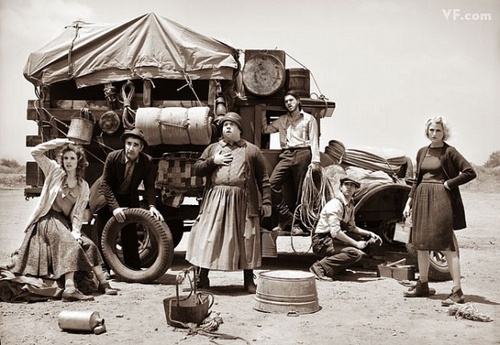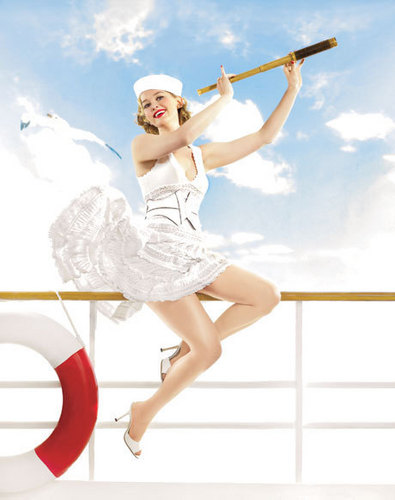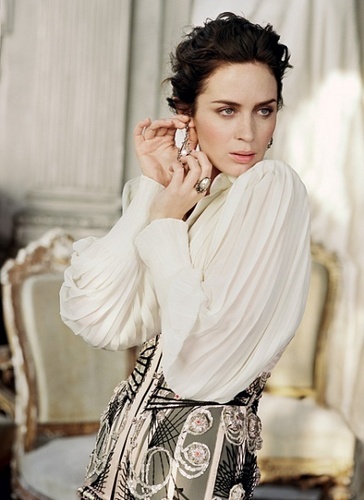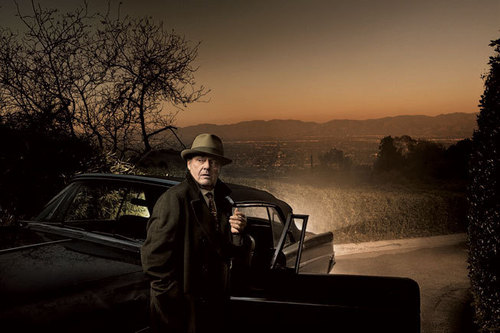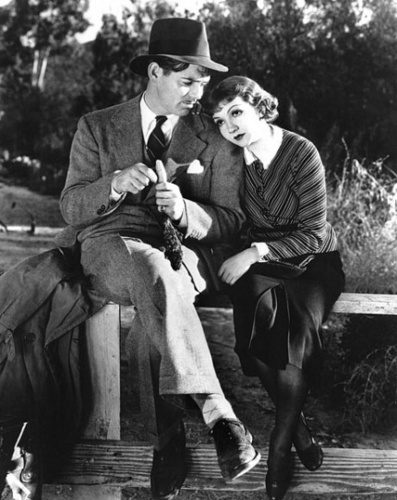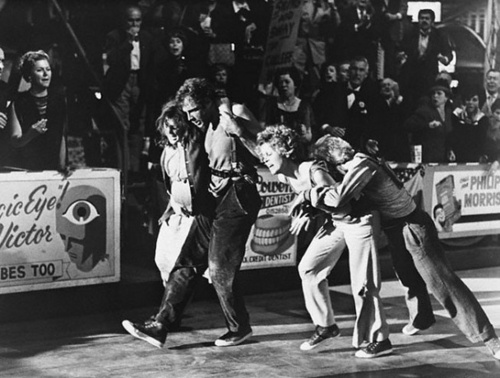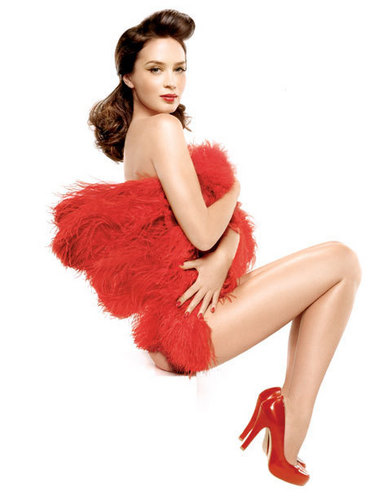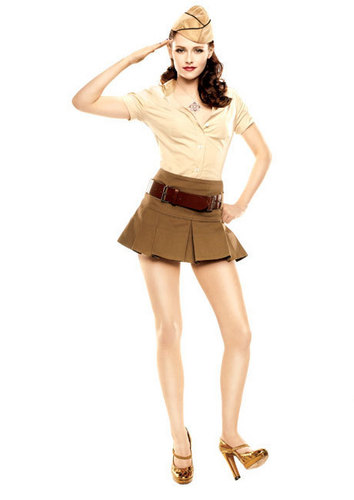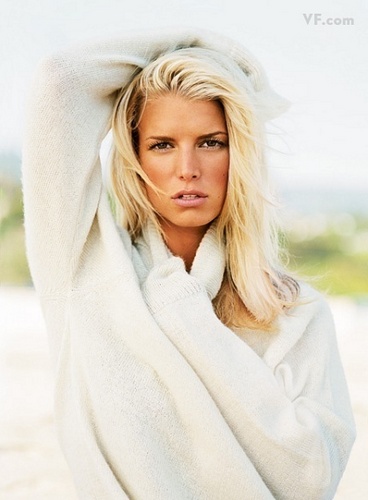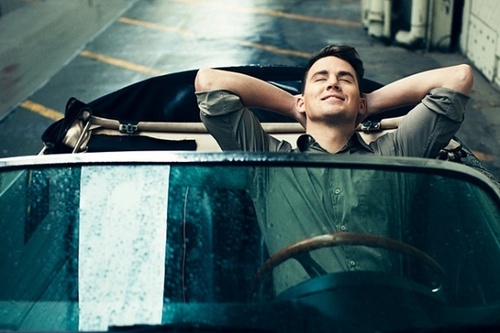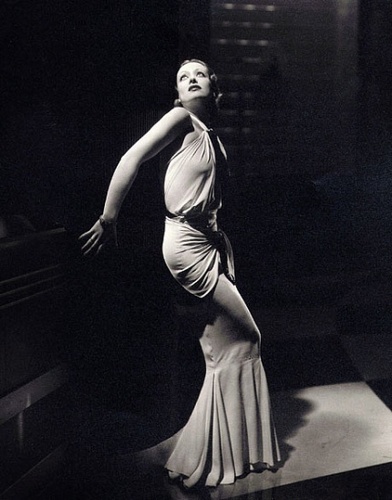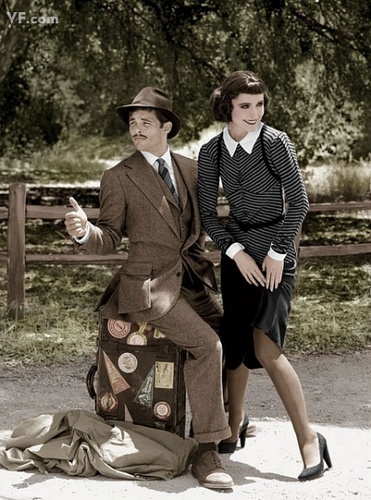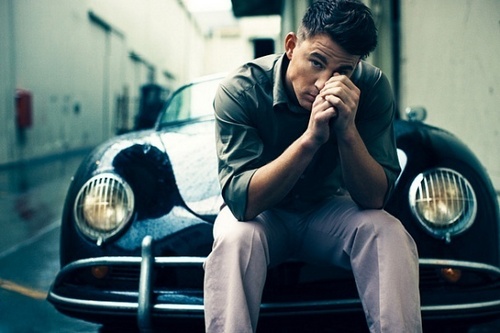Angelina Jolie isn’t interested in normal—whether it’s the size of her bed, the creation of her family, or her latest role (originally intended for Tom Cruise), in Salt. On Venice’s Grand Canal, where Jolie, Brad Pitt, and their six kids moved while she filmed The Tourist with Johnny Depp, the author discovers how a modern-day goddess engages with the mortal concepts of marriage, motherhood, and career.
Related: “Angelina, Uninterrupted,” a retrospective of Jolie’s appearances in the pages of Vanity Fair and more photos from the photoshoot.
By Rich Cohen•Photographs by Patrick Demarchelier
August 2010
Here’s how Angelina Jolie enters the story: by water taxi, a wood boat polished to a high sheen, fluttering three flags, speeding across the black water of a Venetian lagoon. She is seen from above, from the window of a very old palace—it had once been the home of a nobleman, then a monastery, then an embassy, and is now a hotel, which is the entire story of Venice. I want to slow the picture here, show her frame by frame (the way Hitchcock first shows Grace Kelly in Rear Window, when she leans in to kiss Jimmy Stewart): first her arm, long and elegant, a gloved hand reaching out for help. Then a foot on the stairs. Then another. Then Jolie herself. She is stunning in a period sort of way. She’s in a black evening gown and a cape, which, I’m later told, was made for her by “Oscar-winning costume designer Colleen Atwood.”
She sits in an antique chair and sighs. Her tattoos have been covered with makeup. You can see where they are by the powder, which looks like a burn. Her hair is pulled back, her lips are full, her eyes huge and alien, her head alien also, too big for her body, for her narrow shoulders and skinny waist—alien in that big-headed Martian way, proportions that Hollywood and conspiracy theorists use to denote species of a higher evolutionary order, whether of good or ill intent. Her back is red where the main phrase of her dominant tattoo is covered: “Know Your Rights,” which, she says, comes from the Clash song. Covering these words seems symbolic, but I’m not sure how, or of what.
The room is the Presidential Suite of the Dei Dogi hotel. It’s been reserved for the purpose of this interview, giving the affair the feel of a tryst, afternoon delight, rooms rented by the hour. There is a sleeping loft, a ceiling crossed by wooden beams, paintings of knights. There are French windows, some which look over red roofs, some which look out on San Michele, the island of the dead, and Murano, the island of the glassblowers, as well as the airport—we can see planes alighting like egrets—which fills Jolie with dreams of escape.
The 35-year-old actress is here to film The Tourist, which is, in a way, a play on Hitchcock’s To Catch a Thief, all rooftops and canals, waltzes and blue moods, a caper in the most mysterious city in the world, where everything is doubled by its own watery reflection. Somewhere in town is Brad Pitt, with the six kids, the nannies, and the teachers and help. Johnny Depp, Jolie’s co-star, is somewhere here, too. The paparazzi swarm with their cameras, the tourists swarm with their feet, and a cloud of volcanic ash swarms overhead.
Venice is the perfect city for Jolie. It is, in fact, the perfect city for movie stars in general. It’s the city that, with its heroic paintings of prophets and saints, paved the way for the pop icon. It’s a city of images, of cult idols on movie posters, though, of course, no one calls them that. Its paintings are like the billboards on Sunset Boulevard. They’re everywhere. They’re ripe. They’re the people of a lost society saying, “This is what happened to us,” or “We hear this is what happened to those who came before us.” It’s Jesus and Mary and the loaves and the fishes. It’s the theft of the evangelist’s bones storyboarded on the golden arches of the old cathedral. It’s the Adriatic sky, as blue as the blue of blue screen, on which any fantasy can be projected.
I have long believed that celebrity, the way we worship and package and sell our pop stars, is what filled the need for gods that was once filled by the pictures in stained glass. Hollywood is post-Christian Venice, in other words, a pantheon of saints without the hassle and heartache of religion. Seeing Jolie here, in this earlier showbiz capital, you notice just how easily her image fits with the paintings and the icons. You drop a fresh rod into the ancient core and pretty soon the atomic machine is popping and giving off sparks.
Even if Angelina is only here a short time, she’s exactly where she belongs.
‘It’s just so beautiful,” Jolie says. “You get a sense of how people used to take the time to make things. They’d take the time to go out. The opera house is extraordinary. It’s just a different way of living your life. It’s slower, more elegant.”
Jolie and Pitt arrived in Venice at the end of winter. There was snow on the ground, water in the streets. Now and then, coming out of a restaurant or bar—Harry’s, say, where Hemingway put away Bellinis, one, two, three, just like that—they pulled on knee-high gum boots and splashed through the water of St. Mark’s Plaza. Movie stars, the biggest in the world, followed by six children, some adopted, some not, gathered from the corners of the world—Maddox from Cambodia, Zahara from Ethiopia, Shiloh from the womb of the actress, Pax from Vietnam, Knox and Vivienne, the twins, born in Nice, France, in 2008—playing in this mock Byzantium. They moved into a house on the Grand Canal, a huge place, white with blue awnings and high windows, that long ago, when Venice had been a power in the maritime world, belonged to an aristocratic family. The house is a stone’s throw from Saint Angelo Square, a few water doors from the house where Byron once lived and swam in the canal, which, by the way, you can’t do anymore. (During the filming of David Lean’s Summertime, Katharine Hepburn fell into one of the canals, and, so the story goes, was never again the same physically.)
The Jolie-Pitts settled into a routine, became Venetians, sank themselves into a new life, this being a great pleasure of Angie’s existence, the fruit of all those cities with no permanent home—she’s forever shuffling the deck, trading fantasy for fantasy. And now it’s Venice! “It puts you in the perspective of history,” she told me. “You feel like you’re just passing through this place, borrowing it for a while. In a hundred years, it will be the next group, then the next. Big old cities do that.”
In Venice, the kids, who live something like army brats, forever relocating to a new base, and something like subjects in a social experiment—gather six children from four cultures, put them in the care of two of the world’s biggest stars, move them from city to city, observe—resumed their scholastic routine, which, according to Jolie, follows a traditional program, but seems more like her own invention. “We have two teachers who travel with us, and we found a wonderful local man who teaches them the history of Venice and some Italian,” she explained. “It’s a nice mix—this is what we do. They go to school every day 10 to 4 at home. They’re on the Lycée curriculum. We keep them in that system when we’re back in L.A., and in New York they sometimes go to a Lycée school.”
Jolie and Pitt, who are helped, of course, but no one knows just how much—in this world, the struts and supports, the nannies and maids, remain hidden—have worked out a program: they alternate, one making a movie while the other stays with the kids. “I keep telling Brad he owes me,” said Jolie. “He’s had a few months off in one of the most beautiful cities in the world with the children. And he’s such an artist and goes to the stone yards and the art exhibits, and loves being in such a cultural place,” while Jolie’s stuck at work till all hours with Johnny Depp.
Many days, Pitt takes the children on an outing, another boat ride to another church or museum. (One morning, for example, he took them, along with Depp’s kids, fishing for crabs.) He then heads back to the office he set up in his rented house, to talk on the phone and work on his art. “He sculpts and designs,” Jolie told me. “He makes furniture, sculpts things related to houses. Traditional male.”
When I asked Jolie if Pitt still has that wispy beard that had been seen in every tabloid, that strange, Lebowski-like concoction, she smiled sadly and said, “Yes, he does.”
When I asked her opinion of it, she smiled, again sadly, and said, “I love Brad in every state.”
By the time I arrived, the Jolie-Pitts were so settled in Venice they were, in fact, ready to leave. (From here, they would go to their home in the South of France, then to Los Angeles, where Jolie becomes the stay-at-home while Pitt films Moneyball, based on the book by V.F. contributing editor Michael Lewis.) When I asked if she ever got tired of all the running around, she said no, this has always been her preferred way: the life of the high-end nomad, moving from town to town. “Brad’s the same,” she told me. “That’s one of the things that brought us together.” Like the hero of Apocalypse Now, wherever Jolie is, she wants to be in the other place. This can make her seem removed, less like a person living in the now than like someone living in the five minutes from now. She seems both mystical and beyond petty nationalism, but her footloose drive for new experience is pure Americana. “Anytime I feel lost, I pull out a map and stare,” she told me. “I stare until I have reminded myself that life is a giant adventure, so much to do, to see.”
When a movie star sits and talks to you, it’s almost always, and only, because she’s promoting something. In this case, Salt, directed by Phillip Noyce, co-starring Liev Schreiber, which opens this month and which, with its hanging chad of an ending, seems meant to start a Bourne-like franchise, in this case chronicling the exploits of the ass-kicking Evelyn Salt. Most of the time, the thing being sold is of no special interest, but Salt—how it came about, anyway—really does say something significant about Jolie. It goes to character, as they say in court.
“It started with a call from Amy [Pascal, co-chairman of Sony Pictures],” Jolie told me. “She asked if I wanted to play a Bond girl. I said, ‘No, I’m not comfortable with that, but I would like to play Bond.’ We laughed, and then, about a year later, she called back and said, ‘I think I found it.’ ”
Related: “Angelina, Uninterrupted,” a retrospective of Jolie’s appearances in the pages of Vanity Fair and more photos from the photoshoot.
By Rich Cohen•Photographs by Patrick Demarchelier
August 2010
Here’s how Angelina Jolie enters the story: by water taxi, a wood boat polished to a high sheen, fluttering three flags, speeding across the black water of a Venetian lagoon. She is seen from above, from the window of a very old palace—it had once been the home of a nobleman, then a monastery, then an embassy, and is now a hotel, which is the entire story of Venice. I want to slow the picture here, show her frame by frame (the way Hitchcock first shows Grace Kelly in Rear Window, when she leans in to kiss Jimmy Stewart): first her arm, long and elegant, a gloved hand reaching out for help. Then a foot on the stairs. Then another. Then Jolie herself. She is stunning in a period sort of way. She’s in a black evening gown and a cape, which, I’m later told, was made for her by “Oscar-winning costume designer Colleen Atwood.”
She sits in an antique chair and sighs. Her tattoos have been covered with makeup. You can see where they are by the powder, which looks like a burn. Her hair is pulled back, her lips are full, her eyes huge and alien, her head alien also, too big for her body, for her narrow shoulders and skinny waist—alien in that big-headed Martian way, proportions that Hollywood and conspiracy theorists use to denote species of a higher evolutionary order, whether of good or ill intent. Her back is red where the main phrase of her dominant tattoo is covered: “Know Your Rights,” which, she says, comes from the Clash song. Covering these words seems symbolic, but I’m not sure how, or of what.
The room is the Presidential Suite of the Dei Dogi hotel. It’s been reserved for the purpose of this interview, giving the affair the feel of a tryst, afternoon delight, rooms rented by the hour. There is a sleeping loft, a ceiling crossed by wooden beams, paintings of knights. There are French windows, some which look over red roofs, some which look out on San Michele, the island of the dead, and Murano, the island of the glassblowers, as well as the airport—we can see planes alighting like egrets—which fills Jolie with dreams of escape.
The 35-year-old actress is here to film The Tourist, which is, in a way, a play on Hitchcock’s To Catch a Thief, all rooftops and canals, waltzes and blue moods, a caper in the most mysterious city in the world, where everything is doubled by its own watery reflection. Somewhere in town is Brad Pitt, with the six kids, the nannies, and the teachers and help. Johnny Depp, Jolie’s co-star, is somewhere here, too. The paparazzi swarm with their cameras, the tourists swarm with their feet, and a cloud of volcanic ash swarms overhead.
Venice is the perfect city for Jolie. It is, in fact, the perfect city for movie stars in general. It’s the city that, with its heroic paintings of prophets and saints, paved the way for the pop icon. It’s a city of images, of cult idols on movie posters, though, of course, no one calls them that. Its paintings are like the billboards on Sunset Boulevard. They’re everywhere. They’re ripe. They’re the people of a lost society saying, “This is what happened to us,” or “We hear this is what happened to those who came before us.” It’s Jesus and Mary and the loaves and the fishes. It’s the theft of the evangelist’s bones storyboarded on the golden arches of the old cathedral. It’s the Adriatic sky, as blue as the blue of blue screen, on which any fantasy can be projected.
I have long believed that celebrity, the way we worship and package and sell our pop stars, is what filled the need for gods that was once filled by the pictures in stained glass. Hollywood is post-Christian Venice, in other words, a pantheon of saints without the hassle and heartache of religion. Seeing Jolie here, in this earlier showbiz capital, you notice just how easily her image fits with the paintings and the icons. You drop a fresh rod into the ancient core and pretty soon the atomic machine is popping and giving off sparks.
Even if Angelina is only here a short time, she’s exactly where she belongs.
‘It’s just so beautiful,” Jolie says. “You get a sense of how people used to take the time to make things. They’d take the time to go out. The opera house is extraordinary. It’s just a different way of living your life. It’s slower, more elegant.”
Jolie and Pitt arrived in Venice at the end of winter. There was snow on the ground, water in the streets. Now and then, coming out of a restaurant or bar—Harry’s, say, where Hemingway put away Bellinis, one, two, three, just like that—they pulled on knee-high gum boots and splashed through the water of St. Mark’s Plaza. Movie stars, the biggest in the world, followed by six children, some adopted, some not, gathered from the corners of the world—Maddox from Cambodia, Zahara from Ethiopia, Shiloh from the womb of the actress, Pax from Vietnam, Knox and Vivienne, the twins, born in Nice, France, in 2008—playing in this mock Byzantium. They moved into a house on the Grand Canal, a huge place, white with blue awnings and high windows, that long ago, when Venice had been a power in the maritime world, belonged to an aristocratic family. The house is a stone’s throw from Saint Angelo Square, a few water doors from the house where Byron once lived and swam in the canal, which, by the way, you can’t do anymore. (During the filming of David Lean’s Summertime, Katharine Hepburn fell into one of the canals, and, so the story goes, was never again the same physically.)
The Jolie-Pitts settled into a routine, became Venetians, sank themselves into a new life, this being a great pleasure of Angie’s existence, the fruit of all those cities with no permanent home—she’s forever shuffling the deck, trading fantasy for fantasy. And now it’s Venice! “It puts you in the perspective of history,” she told me. “You feel like you’re just passing through this place, borrowing it for a while. In a hundred years, it will be the next group, then the next. Big old cities do that.”
In Venice, the kids, who live something like army brats, forever relocating to a new base, and something like subjects in a social experiment—gather six children from four cultures, put them in the care of two of the world’s biggest stars, move them from city to city, observe—resumed their scholastic routine, which, according to Jolie, follows a traditional program, but seems more like her own invention. “We have two teachers who travel with us, and we found a wonderful local man who teaches them the history of Venice and some Italian,” she explained. “It’s a nice mix—this is what we do. They go to school every day 10 to 4 at home. They’re on the Lycée curriculum. We keep them in that system when we’re back in L.A., and in New York they sometimes go to a Lycée school.”
Jolie and Pitt, who are helped, of course, but no one knows just how much—in this world, the struts and supports, the nannies and maids, remain hidden—have worked out a program: they alternate, one making a movie while the other stays with the kids. “I keep telling Brad he owes me,” said Jolie. “He’s had a few months off in one of the most beautiful cities in the world with the children. And he’s such an artist and goes to the stone yards and the art exhibits, and loves being in such a cultural place,” while Jolie’s stuck at work till all hours with Johnny Depp.
Many days, Pitt takes the children on an outing, another boat ride to another church or museum. (One morning, for example, he took them, along with Depp’s kids, fishing for crabs.) He then heads back to the office he set up in his rented house, to talk on the phone and work on his art. “He sculpts and designs,” Jolie told me. “He makes furniture, sculpts things related to houses. Traditional male.”
When I asked Jolie if Pitt still has that wispy beard that had been seen in every tabloid, that strange, Lebowski-like concoction, she smiled sadly and said, “Yes, he does.”
When I asked her opinion of it, she smiled, again sadly, and said, “I love Brad in every state.”
By the time I arrived, the Jolie-Pitts were so settled in Venice they were, in fact, ready to leave. (From here, they would go to their home in the South of France, then to Los Angeles, where Jolie becomes the stay-at-home while Pitt films Moneyball, based on the book by V.F. contributing editor Michael Lewis.) When I asked if she ever got tired of all the running around, she said no, this has always been her preferred way: the life of the high-end nomad, moving from town to town. “Brad’s the same,” she told me. “That’s one of the things that brought us together.” Like the hero of Apocalypse Now, wherever Jolie is, she wants to be in the other place. This can make her seem removed, less like a person living in the now than like someone living in the five minutes from now. She seems both mystical and beyond petty nationalism, but her footloose drive for new experience is pure Americana. “Anytime I feel lost, I pull out a map and stare,” she told me. “I stare until I have reminded myself that life is a giant adventure, so much to do, to see.”
When a movie star sits and talks to you, it’s almost always, and only, because she’s promoting something. In this case, Salt, directed by Phillip Noyce, co-starring Liev Schreiber, which opens this month and which, with its hanging chad of an ending, seems meant to start a Bourne-like franchise, in this case chronicling the exploits of the ass-kicking Evelyn Salt. Most of the time, the thing being sold is of no special interest, but Salt—how it came about, anyway—really does say something significant about Jolie. It goes to character, as they say in court.
“It started with a call from Amy [Pascal, co-chairman of Sony Pictures],” Jolie told me. “She asked if I wanted to play a Bond girl. I said, ‘No, I’m not comfortable with that, but I would like to play Bond.’ We laughed, and then, about a year later, she called back and said, ‘I think I found it.’ ”




